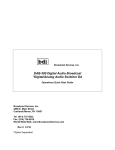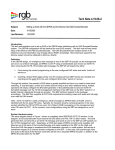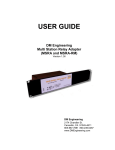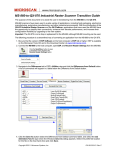Download BDI ATB-300 Specifications
Transcript
Broadcast Devices, Inc. ATB-300 Audio Tool Box *Digital/Analog Audio Switcher DA Operations Quick Start Guide Broadcast Devices, Inc. 2066 E. Main Street Cortlandt Manor, NY 10567 Tel. (914) 737-5032 Fax. (914) 736-6916 World Wide Web: www.Broadcast-Devices.com Rev D. 05/09 *Option Dependent Table of Contents I. Basic Description 3 II. ATB-300 Operational Mode Descriptions A. Memory Programming B. Silence Interval Programming C. Silence Threshold Programming 3–7 4 4 5 III. Remote Control Operation 7 IV. Input Mode Selection Menu System 7-9 V. Audio I/O Connector Diagrams 9 - 10 VI. Remote Control Connector Diagrams 11 VII. Warranty 12 2 I. Basic Description Basic Description by model number: ATB-300-1 4 – AES I/O Digital only switcher/router ATB-300-2 4 – AES I/O and 4 -analog L/R input switcher/router ATB-300-3 4 - AES I/O and 4 - analog L/R output switcher/router ATB-300-4 4 – Analog only I/O ATB-300-5 4 - AES I/O, 4 – analog L/R balanced I/O ATB-300-6 8 – AES I/O ATB-300-7 8 – Analog Input 4 Analog Output ATB-300-8 8 – Analog I/O ATB-300 DAS – Special Configuration for use with Digital Alert Systems DASDEC EAS System – 4 individual A/B switchers AES and or Analog I/O – Call for configuration information ATB-300 is a 4 or 8 channel stereo analog / digital audio switcher featuring silence detection and automatic switching. Input and output types are defined by the model number as shown above. The ATB-300 can be used to manually switch inputs or will automatically switch when a programmable silence interval of between 30 and 600 seconds is detected. Auto switching is programmed using a “priority list” of 4 or 8 memories depending on configuration which are programmed with input channels to search for audio in order of preference. The ATB-300's intelligent search algorithm constantly monitors the inputs to allow immediate switching to the first active channel in the priority list without need to sequence through inactive channels when silence. II. ATB-300 Operational Mode Descriptions ATB-300 Manual Mode The ATB-300 defaults to MANUAL mode upon power up. The LCD display will indicate the manual mode as well as the currently selected input channel and the active / inactive status of that input on the top line. The lower line indicates the channel that will be switched to the outputs when the green ENTER (check mark) key is pressed. The UP and DOWN arrows are used to select the input channel. The activity status of that channel is also shown to avoid switching to an inactive channel. When the select key is pressed the new selection is stored to memory and the audio is switched. This setting is NON VOLATILE. If the ATB-300 is power cycled this channel will be selected on power up. 3 Figure 1 - ATB-300 Manual Mode Display In manual mode the user may also program the priority memories, the silence interval and the relative audio threshold which triggers the active / inactive determination. M A NU A L CH1 SELECTED I NPU T: CH 1 NO A U DI O A. Memory Programming PRI 1 CH 1 NO A U DI O I NPU T: CH 1 NO A U DI O Figure 2 - ATB-300 Priority Memory Programming Mode Display Pressing the F2/F5 key will enter the memory programming mode. In this mode, the top line of the LCD indicates the current memory (PRI 1 to PRI 8) being programmed, its contents and the activity status of that channel. The lower line indicates the channel that will be programmed into the memory when the ENTER key is pressed along with its activity status. The LEFT and RIGHT ARROW keys are used to select a memory to program. The UP and DOWN keys sequence through the input channel selections. Pressing the ENTER key will program the channel indicated on the bottom line in to the priority memory. Note that programming the same channel into more than one memory is possible and can be done to avoid having an unconnected input in the priority memory list. The factory default memory channels are programmed to sequence through the 8 possible inputs in numerical order. B. Silence Interval Programming A U DI O LOSS TI M EOU T SECONDS = 60 Figure 3 - ATB-300 Silence Interval Program Mode Display 4 Pressing the F3/F6 Key will allow programming the silence interval. Select the desired interval using the UP and DOWN arrow keys. The interval can be set to any time between 30 and 600 seconds (Default = 60 seconds) using the UP and DOWN arrow keys. Pushing the ENTER key will put this setting into non-volatile memory. Pushing the red X key will return to the original value before it was changed. NOTE: the ENTER key MUST be pushed to retain this setting after power is cycled. This allows the user to test a setting before committing it to memory. C. Silence Threshold Programming OU TPU T LEV EL = 341 SI LENCE LEV EL = 5 Figure 4 - ATB-300 Silence Threshold Programming Mode Display Pressing the F3/F6 Key again will allow programming of the silence detect level. The upper line of the LCD indicates the level of the currently selected input for comparison purposes. The lower line indicates the current threshold below which a channel will be considered INACTIVE. The relative level can be set to any time between 1 and 100 (Default = 5 = - 40 dB below nominal input) using the UP and DOWN arrow keys. Pushing the ENTER key will put this setting into non-volatile memory. Pushing the red X key will return to the original value before it was changed. NOTE: the ENTER key MUST be pushed to retain this setting after power is cycled. This allows the user to test a setting before committing it to memory. Manual operation is also available using the rear panel remote connections. See “Remote Operation” for details NOTE: The ATB-300 has an internal 2 pin jumper installed on the back of the front panel board in the upper right hand corner near the power connector. Removing this jumper will disable front panel programming of the silence detect time and activity threshold to prevent unauthorized changes. ATB-300 Auto Mode Pushing the F1/F4 key will alternate between the manual and auto modes. In auto mode the display will indicate the currently selected channel and its activity status. The lower line indicates the status of the priority memories and the activity status of the input channel programmed into them. Pushing the UP and DOWN keys will allow previewing the contents of each priority memory. 5 A U TO CH1 A U DI O OK PRI 1 CH 3 NO A U DI O Figure 5 - ATB-300 Auto Mode Display When the ATB-300 detects an audio level below the silence threshold for the pre selected time interval it will look at the priority memories and switch the lowest priority channel which is active to the output. The display will indicate a loss of audio on the top line of the LCD and will indicate the input which was switched to the output on the lower line along with its activity status. It will also close the fault detected relays contacts available on the rear panel remote connector. Pushing the red X key will reset the warning as well as the relays. If the rear panel remote is enabled, an input is provided to do this using an external closure as well. A U DI O LOSS DETECTED A U TO CH 5 A UDI O OK Figure 6 - ATB-300 Silence Detected Display Note that the ATB-300 is capable of detecting a subsequent loss of audio on the channel that was automatically selected. If such an event should occur, the priority list will again be used to select the first available active channel in the list. Audio Restored Look Back Feature The ATB-300 has the ability to monitor the designated primary channel after a loss of audio has been detected by the silence sensor if the unit is in the automatic mode. If audio is restored to the primary channel after a user programmed number of minutes the unit will revert back to the primary channel automatically. The factory default setting for the look back feature is disabled. To enable the look back feature follow the procedure below: 1. Place the unit in the manual mode by pressing F1 2. Toggle F3 until the display says AUTO RETURN FUNCTION – factory default is DISABLED. 3. Press the UP arrow to set the number of minutes the unit should wait before reverting back to the primary channel only after audio has been restored to the primary channel. The unit can wait from 1 to 60 minutes before reverting back to the primary channel. 6 4. Place the unit back into the AUTO mode by pressing F1 twice. The first press of F1 takes the unit out of the programming mode and into MANUAL. The second press of F1 places the unit back into AUTO mode. III. REMOTE CONTROLLED OPERATION The ATB-300 provides remote inputs to select between manual and auto modes, reset a fault warning, selection of an input and to enable/disable remote operation. Open collector status outputs are provided to indicate the currently selected input channel. These outputs are capable of sinking up to 100ma and are rated at a maximum of 30v DC. To enable remote operation the REMOTE ENABLE input must be connected to the remote common (ground). Refer to page 9 “ATB-300 Remote Connections” diagram for connection information. The REMOTE AUTO or REMOTE AUTO inputs are used to select the switching mode by connecting the desired mode selection pin to remote common momentarily. To enable remote channel selection, the ATB-300 must be in MANUAL mode. When the ATB-300 is in MANUAL mode, connecting a remote channel select input to remote common momentarily will cause the corresponding input to be selected as the current output. ONLY ONE channel select input can be active. If more than one input is selected simultaneously the ATB-300 will not switch. IV. Input Mode Selection Menu Operation The ATB-300 inputs can be configured for mode of operation on an individual basis. Stereo, Mono Left, Mono Right, L+R and Stereo Swap can be configured from the front panel. Use mono left and mono right to fill in a missing channel. For example; choosing mono left will take a signal only input on the left channel and apply it to both channels at the output of the unit. Use L+R to create a monaural input from a stereo source. To select the input mode push F4 once. The display will indicate that you are in the INPUT MODE SELECTION menu. Select the input channel pair (1-8) using the up and down arrow keys. The left and right arrow keys are then used to select between the following modes: 7 Press F4 once: Input Mode Selection Pushing the up arrow/down allows you to select the input channel to be changed: Pushing the left/right arrow buttons allows selection of the following input modes: OFF Stereo - Factory Default LR Swap - L/R Channels Swapped Mono L - L input fed to both L & R outputs Mono R - R input fed to both L & R outputs L + R - L & R inputs are summed and fed to both L & R outputs. The input mode is automatically saved when selected. To exit this menu press the F1 key to return to the main menu. Press F4 twice: Input Invert Control – Phase Inversion Pushing the up arrow/down allows you to select the input channel to be changed: Pushing the left/right arrow buttons allows selection of the following input modes: Normal Invert Left Invert Right Note: Phase inversion is Left or right but not both simultaneously. Input Invert Control modes are automatically saved when selected. To exit this menu press the F1 key to return to the main menu. Press F4 three times to enter Input Gain Control menu Pushing the up arrow/down allows you to select the input channel to be changed: Pushing the left/right arrow buttons allows you to adjust gain in one dB increments +/10 dB Press F4 four times and the display will indicate Output Gain Control Pushing the up arrow/down allows you to select the output channel to be changed: Pushing the left/right arrow buttons allows you to adjust gain in one dB increments +/10 dB Factory default for input and output gain controls is 0 dB. When factory default gains are used AES3 I/O is unity. When AES3 inputs are output to an analog channel the analog output will correspond to –10 dB below full scale AES3 input when AES3 input is nominal – 10 dB below full scale. 8 ATB-300 Factory Default Recovery As with any programmable device, it is possible that the user would like to quickly return to the “factory default” settings. To return the ATB-300 to its factory configuration remove AC power to the unit. While holding the red “X” key, restore AC power until the display indicates “FACTORY DEFAULT”. V. Audio I/O Connections ATB-300 Audio Connections DIGITAL AUDIO I/O 1 14 2 15 3 16 4 17 5 18 6 19 7 20 8 21 9 22 10 23 11 24 12 25 13 AESOUTP4 AESOUTN4 CH4 OUT AESINP4 AESINN4 CH4 IN AESOUTP3 AESOUTN3 CH3 OUT AESINP3 AESINN3 CH3 IN AESOUTP2 AESOUTN2 CH2 OUT AESINP2 AESINN2 CH2 IN AESOUTP1 AESOUTN1 CH1 OUT AESINP1 AESINN1 CH1 IN DB-25 9 ANALOG AUDIO - INPUT & OUTPUT PINOUTS ARE IDENTICAL 1 14 2 15 3 16 4 17 5 18 6 19 7 20 8 21 9 22 10 23 11 24 12 25 13 CH8P CH8N CH8 RIGHT CH7P CH7N CH8 LEFT CH6P CH6N CH 7 RIGHT CH5P CH5N CH 7 LEFT CH4P CH4N CH 6 RIGHT' CH3P CH3N CH 6 LEFT CH2P CH2N CH5 RIGHT CH1P CH1N CH5 LEFT DB-25 ATB-300 AUDIO INPUT MAPPING INPUT CHANNEL 1 2 3 4 5 6 7 8 TYPE DIGITAL DIGITAL DIGITAL DIGITAL ANALOG ANALOG ANALOG ANALOG 10 LOCATION AES 1 AES 2 AES 3 AES 4 ANALOG IN 1-2 (L/R) ANALOG IN 3-4 (L/R) ANALOG IN 5-6 (L/R) ANALOG IN 7-8 (L/R) VI. Remote Control Connections ATB-300 Remote Connections REMOTE P1 1 14 2 15 3 16 4 17 5 18 6 19 7 20 8 21 9 22 10 23 11 24 12 25 13 INPUT COM INPUT COM INPUT COM INPUT COM INPUT COM INPUT COM INPUT COM +12V CHASSIS DB-25 FEMALE (USER SUPPLIED) SELECT-INPUT1 STATUS1 SELECT-INPUT2 STATUS2 SELECT-INPUT3 STATUS3 SELECT-INPUT4 STATUS4 SELECT-INPUT5 STATUS5 SELECT-INPUT6 STATUS6 SELECT-INPUT7 STATUS7 SELECT-INPUT8 STATUS8 REMOTE P2 1 14 2 15 3 16 4 17 5 18 6 19 7 20 8 21 9 22 10 23 11 24 12 25 13 K1-COM K1-NC K1-NO K2-COM K2-NC K2-NO FAULT DETECTED RELAYS AUTO AUTO-COM MANUAL MANUAL-COM REMOTE ENABLE REMOTE ENABLE COM FAULT RESET FAULT RESET COM REMOTE INPUTS CHASSIS DB-25 MALE (USER SUPPLIED) Notes: 1. Status outputs are open collector Darlington transistors capable of sinking 100ma @ 30v DC. 2. Select and remote inputs are momentary closures with internal 4.7K pullup resistors to 5v DC. 11 VII. Warranty Broadcast Devices, Inc. products are warranted against failure due to faulty materials or workmanship for a period of one year from the date of shipment to the ultimate user. The warranty covers repair or replacement of defective parts at the factory, provided the unit has been returned prepaid by the user. All shipments to the factory shall have affixed to the outside of the container a return authorization number obtained from the factory. The above warranty is void if the unit has been modified by the user outside of any recommendations from the factory or if the unit has been abused or operated outside of its electrical or environmental specifications. If customer conducted field tests suggest that the unit may be faulty, whether or not the unit is in warranty, a full report of the difficulty should be sent to Broadcast Devices, Inc. factory at Cortlandt Manor, New York. The office may suggest further tests or authorize return for factory evaluation. Units sent to the factory should be well packed and shipped to Broadcast Devices, Inc. 2066 E. Main Street, Cortlandt Manor, NY 10567. Remember to affix the R.A. number to the outside of the carton. Any packages received without such R.A. number will be refused. Note: freight collect shipments will also be refused. When the unit has been received, inspected and tested, the customer will receive a report of the findings along with a quotation for recommended repairs, which are found falling outside of the standard warranty. Units returned for in-warranty repairs, which are found not to be defective will be subject to an evaluation and handling charge. In-warranty units will be repaired at no charge and returned via prepaid freight. Out-of-warranty units needing repair require a purchase order and will be invoiced for parts, labor, and shipping charges. When ordering replacement part, always specify A) Part Description, and Quantity; B) Date of Purchase, Where Purchased; C) Any Special Shipping Instructions. Always specify a street address, as shipping companies cannot deliver to a postal box. Broadcast Devices, Inc. is not responsible for any other manufacturer’s warranty on original equipment. Nor are we responsible for any failure, damage, or loss of property that may occur due to the installation or operation of our equipment outside of recommended specifications. Broadcast Devices, Inc. reserves the right to change materials, specifications, and features from time to time. www.broadcast-devices.com Broadcast Devices, Inc. 2066 E. Main Street Cortlandt Manor, NY 10567 Email: [email protected] (914) 737-5032 Tel. (914) 736-6916 Fax. 12 13 14





















